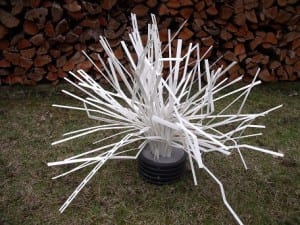A primary goal of the Program is to increase fish habitat quality and quantity to support increased salmonid populations. Changes in rearing habitat availability for salmonids were assessed over the 40 miles of the Trinity River and pre- and post-construction at channel rehabilitation sites.
Site Evaluation
Habitat assessments are conducted at bank rehabilitation sites and at randomized river segments (GRTS design) by mapping the boundaries of the habitat using the numeric criteria for water depth, velocity and presence of cover or substrate. Most sites measured thus far have increased juvenile fish habitat post-construction (report pending).
 As reported in the TRRP 2009 Annual Report, the Sven Olbertson site was intended to provide 114,000 square feet of complex side channel habitat: the mapped habitat indicated 67,000 square feet of habitat for fry and 82,000 square feet for pre-smolts. Hoadley Gulch site was intended to provide 26,400 square feet of complex salmonid side channel rearing habitat during winter low flow releases. Post-construction, 9,200 square feet of habitat for fry and 12,800 square feet habitat for pre-smolts was measured. Lewiston Cableway site monitoring showed that fry habitat increased by 57 % and pre-smolt habitat increased by 36 % after construction.
As reported in the TRRP 2009 Annual Report, the Sven Olbertson site was intended to provide 114,000 square feet of complex side channel habitat: the mapped habitat indicated 67,000 square feet of habitat for fry and 82,000 square feet for pre-smolts. Hoadley Gulch site was intended to provide 26,400 square feet of complex salmonid side channel rearing habitat during winter low flow releases. Post-construction, 9,200 square feet of habitat for fry and 12,800 square feet habitat for pre-smolts was measured. Lewiston Cableway site monitoring showed that fry habitat increased by 57 % and pre-smolt habitat increased by 36 % after construction.
In order to validate fish use of the mapped rearing habitat, snorkeling has been used to count fish inside and outside of the mapped habitat areas. Chinook juvenile counts inside designated rearing habitats averaged at least 30 fish per site, whereas counts outside of rearing habitat designations averaged less than five fish per site.
See the dozens of unique artificial fish habitat models, fish attractors and fish cover used at fishiding.com, the industry leader and only science based, man made and artificial fish habitat, proven to provide all fish with cover they prefer to prosper.
Reach Evaluation
Flow and channel rehabilitation actions are anticipated to create changes in habitat availability through the entire 40-mile river reach. Rearing habitat availability was mapped at 32 randomly selected sites. Total area of rearing habitat within the restoration reach is 343,000 square meters (about 3.66 million square feet) for fry, and 436,400 square meters (about 4.7 million square feet) for pre-smolt (figure). The data indicate the greatest amount of rearing habitat occurs near Lewiston Dam and declines longitudinally downstream.
 Pre-smolt rearing habitat declines with distance down river. (reported in the TRRP 2009 Annual Report)
Pre-smolt rearing habitat declines with distance down river. (reported in the TRRP 2009 Annual Report)Suggested further reading:
Goodman, D H; Martin, A; Alvarez, J; Davis, A; and Polos, J (2010) Assessing Trinity River salmonid habitat at channel rehabilitation sites, 2007-2008.
Alvarez, J; Goodman, D; and Martin, A (2010) Assessment of changes in anadromous salmonid habitat at selected channel rehabilitation sites on the Trinity River, CA. Oral presentation provided at the 2010 Trinity River Science Symposium.
Saraeva, E and Hardy T B (2009) Upper Trinity River Basin Habitat Assessment. Report to the U.S. Bureau of Reclamation, Trinity River Restoration Program.
Goodman, D H; Martin, A C; Petros, P P; and Klochak J (2009) Judgement based habitat mapping on the Trinity River, 2006.
Chamberlain, C D; Martin, A C; Petros, P P (2007) Trinity River biological monitoring of channel rehabilitation sites: a pre-construction baseline habitat evaluation.
Hampton, M (1988) Development of habitat preference criteria for anadromous salmonids of the Trinity River.
